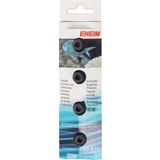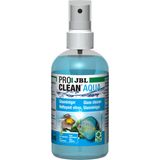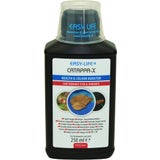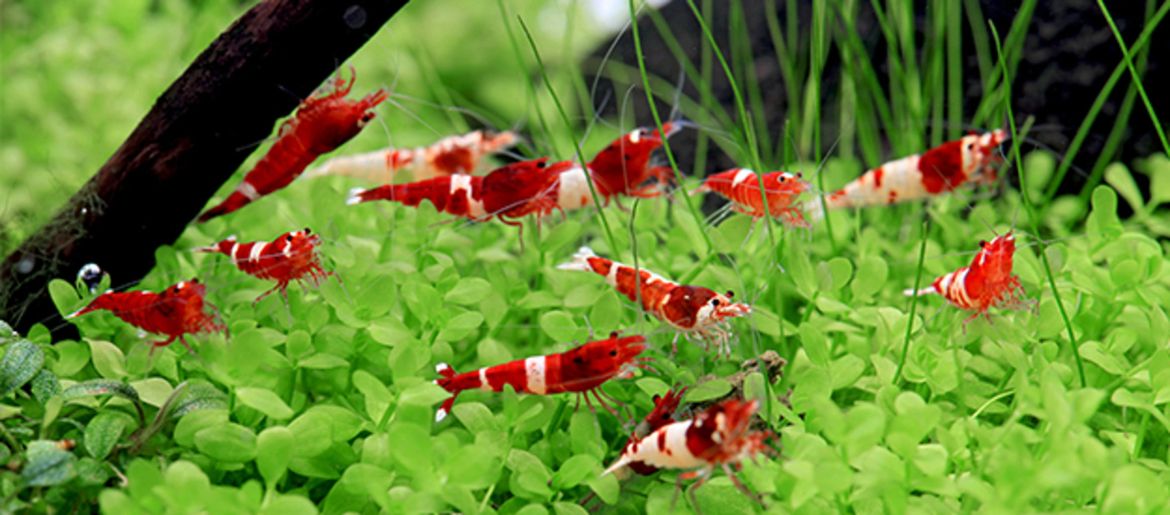Shrimp guidelines
Colourful shrimp in the aquarium!
For fish, there are minimum requirements in Germany - guidelines for keeping them in the aquarium, and in Austria and other countries, there are similar laws. Unlike for fish, these laws and guidelines do not apply to shrimp - so you can keep them completely legally in aquariums under 60 cm in length. The little crawlers easily have enough space in a smaller nano aquarium because the animals do not swim much and live on the surface. You can also design a nano tank so that the small, pretty dwarf shrimp feel really comfortable in it. However, you should note that the internal filters included in the standard complete sets with 54 litres are usually not suitable for shrimp - here they can get inside the filter, where they are chopped up by the filter wheel. Here you either have to buy a shrimp-proof internal filter - or you choose the NanoCube Complete from Dennerle. With this chic part, all accessories were developed with shrimp in mind and tested for their suitability for shrimp.
Nano aquariums are not for beginners? Are you kidding me? Are you serious when you say that!
One very often hears the objection that small aquariums are not for beginners - one can now confidently see that as refuted! The technology is so advanced that there are now high-quality filters, lighting systems and even the possibility of professional CO2 fertilisation for nano aquariums. The selection of aquarium plants is also much larger these days, and there are many more nano plants and even nano aquarium decorations. If you read in a bit and avoid a few basic beginner mistakes right from the start, nothing stands in the way of successful shrimp farming, so - don't be fooled!
An important point in shrimp farming: the water
There are many different dwarf shrimps in the aquarium hobby, which come from different biotopes and therefore also need different water values. Fortunately, today it is the case that you have to choose your desired fill for your tap water. Because a nano aquarium is naturally not particularly large, you can use osmosis water and mineral salt to produce the water that your favourite shrimp need. This is really not difficult at all - the mineral salt is measured accordingly and stirred into the water. That's it, every recipe is more complicated.
Shrimp from soft water!
The prime example of a soft water shrimp is the popular red and white or black and white bee shrimp, also called crystal red or crystal black, a real eye-catcher. It comes from biotopes with very soft water and would like to have that in the aquarium too. You can keep bee shrimp in harder water, but often the offspring do not come up there or the animals get sick, and that does not have to be. Measure the osmosis water and mineral salt with the enclosed spoon and add, stir briefly, pour into the aquarium, and you're done. You really don't need to be afraid of that, the procedure is absolutely not complicated. You can recognise the mineral salt for soft water shrimp by the addition of GH +. The Bee Salt GH + by Dennerle is such a salt that is very suitable for keeping bee shrimp.
Shrimp from hard water!
A great example of hard water shrimp are the great colourful Neocaridina. They can cope with almost all water values that seep out of the line in our latitudes. The relatively insensitive Neocaridina shrimp are definitely suitable for beginners and are good for reproduction and can be kept in tap water in many regions. Then why are there hardening salts for Neocaridina (recognizable by the addition GH / KH +), such as the Shrimp Salt GH / KH + from Dennerle? Unfortunately, the water hardness is not everything - there can be all sorts of undesirable things in tap water, for example, the waterworks sometimes use chlorine or silver because of a germ load, and in some houses, there are still copper pipes for the water - silver, chlorine and copper are very toxic to ours aquarium inhabitants! If you don't want to work with osmosis water and mineral salt, you should drain the water well to prevent copper deposits. More copper is released from the pipes in warm water, so it is better to fill the replacement water for the aquarium cold. If in doubt, just leave it a day in front of the heater so that it can reach room temperature. To eliminate chlorine, run the water over the shower head into your aquarium bucket. The strong water movement reliably drives the chlorine out. You can also whirl the water for your aquarium properly with an air pump for a few hours.
Unfortunately, there is no solution against silver in tap water, but silver is also a deadly poison for shrimp. If you want to be on the safe side here, you'd better get a water purifier that binds all dangerous substances like heavy metals and other stuff that nobody needs in tap water. The Dennerle Clear Water Elixir and the Dennerle Aqua Elixier are such water purifiers. With the Dennerle Clear Water Elixir , the water first becomes a little cloudy and then absolutely clear and brilliantly transparent.
The temperature in the aquarium!
Most dwarf shrimps do not come from tropical regions and do not need to be so terribly warm in the aquarium. Room temperature, i.e. 18 to 24 ° C, is enough for them. A heating element is only necessary if you want to keep shrimp from warmer areas or if you live in an igloo. Here too, Dennerle's Nano Thermo Compact offers ideally fitting heating solutions for your nano aquarium, which are not mercilessly over-dimensioned but are ideal for the small water volume.
The filter in the aquarium - internal filter!
Internal filters are often used in nano aquariums. What you get in retail is unfortunately often not suitable for shrimps, because the filters suck the water through large slots through which smaller shrimps can pass. The inner workings of these internal filters are unfortunately such that the filter wheel is located just behind the slots - here the shrimp are literally chopped up. Dennerle has solved the problem with the nano corner filter. Here the slots are also available (how else should the water get into the filter, there is no other way ...), but the filter is designed so that even the smallest shrimp can definitely not reach the filter wheel - to do so they need tools and shrimp generally cannot operate them. If that's not enough for you - no problem, there is a fine grid to clip onto the filter, the Dennerle Baby Protect . In no time the filter is absolutely baby shrimp safe. For heavily populated aquariums, in which a lot is fed and in which the filter has to do more, we recommend the filter attachment Nano Filter Extension instead of the Baby Protect, with which you can practically double the filter volume.
The filter in the aquarium - external filter and backpack filter!
External filters and backpack filters such as the Dennerle Nano Scaper's Flow Hangon Filter do not live like an internal filter inside the aquarium, but outside the water. The backpack filter hangs on the aquarium glass, the external filter is next to the basin or below, in the aquarium cabinet. The advantage: they do not take up any space in the aquarium (and, to be honest, internal filters are sometimes a bit ugly ...).
With the external filter or the backpack filter, the water inlet is often a weak point in the shrimp pool - the slots are also quite large, and the inside of the filter is not safe for shrimp. You can either defuse these water inlets with an appropriate piece of filter sponge or with a stainless steel tube.
The filter in the aquarium - basics!
No matter which filter type you choose, it must pass through day and night. The actual cleaning work in the filter is done by bacteria that break down organic substances in the water that are potentially harmful to shrimp and render them harmless. To do this, they need oxygen, which freshwater from the aquarium brings them. If you turn the filter off overnight, they will die and then they will no longer work ... so notice: Always let the filter run through.
The filter is cleaned when you find that there is visibly less water coming out - then the filter media are clogged. You simply wash filter mats and similar sponge material under running water - without detergent! If it no longer gets clean, which can happen with filter fleece, for example, you have to insert a new filter cartridge.
Ventilation in the aquarium!
During the day, the plants release oxygen into the water, at night they consume some. If there is a lack of oxygen overnight, which can occur in well-planted tanks, it has proven to be useful to ventilate the aquarium. For example, if the temperature in the water rises in summer, less oxygen is stored. It can also make sense to ventilate the aquarium with a stone and an air pump or with an oxidizer. This is how additional oxygen comes into play, which is good for the aquarium inhabitants.
The substrate in the aquarium
Optimal for shrimp from rather hard water (Neocaridina, Amano and others) is a neutral natural gravel like the Dennerle Plantahunter gravel or shrimp gravel . Here you can live out and also use gravel in different colours or different sized grains. Shrimps from soft water like bee shrimp or Taiwanese like to sit on dark ground, which stabilises the water values and makes the water softer. The Dennerle Shrimp Soil is a good choice for this.
The break-in period
The ecosystem in the aquarium needs to be broken in first. Let your new aquarium run in for at least two weeks without stocking. You do the rest completely: So it is planted, filled with water, and the equipment such as filters, lights and - if available - CO2 is connected and runs like normal operation. The necessary bacteria can now form here, converting toxic ammonia and nitrite into comparatively harmless nitrate. You can accelerate the formation of the bacteria by inoculating your aquarium, i.e. adding a bacterial preparation with live filter bacteria to the fresh basin. For example, the Aquarium Starter Rapid from Dennerle is a highly recommended product.
Then you should also feed your aquarium, which still looks empty, but is just bustling with microscopic life. You can add a little shrimp food to the aquarium - but only a little. So they have something to do and their number adapts to the range of feed. If you use animals after the break-in period, bacteria are already there and the biological burden on your shrimp and snails is limited.
If you measure water during the break-in period - for example with the Dennerle water test strips 6-in-1 - you will find that the longer your aquarium has been run in, you will get very different results. This is because different bacteria let off steam and multiply. First the content of ammonium (NH3) / ammonia (NH4) increases and decreases again, then you can measure the nitrite (NO2), which is toxic to fish and invertebrates, in higher concentrations - this is the so-called nitrite peak. You can only populate your new aquarium with a clear conscience if this substance drops below the detection limit again.
If you have used the Dennerle Aquarium Starter Rapid , it may happen that the nitrite peak is very weak or does not take place at all. If after two weeks nothing has happened and you have vaccinated your aquarium, you can assume that everything fits as far as possible and use shrimp.
The stock in the aquarium!
Shrimp are small, but they do have social behavior and are group animals. From 10 animals per species is a good guideline. The Amano shrimp, for example, are very active shrimp. They swim a lot and are generally very lively, so they need an aquarium with an edge length of at least 60 cm. You can put other dwarf shrimp types in a NanoCube with a capacity of 10 or 20 litres. What is important here is not so much the swimming space as the surfaces on which the dwarfs crouch and which they can graze.
The water change and the aquarium maintenance!
In general, you can say that a weekly water change of 10-30% is optimal. If you feed a lot and fertilise your plants properly, you should change 50% water, so that no unwanted substances accumulate in the water. When changing water, you can also clean the panels. If you do this every week, they won't get so dirty that you can run around with methods other than the alginator. With many shrimp breeders, you will see that they do not clean the back wall and the side windows of the aquarium because here the baby shrimp find a lot of growth and you can watch them grow.
If you want to be absolutely sure that you don't suck in shrimps when you change the water, you can either look closely or simply secure the hose with a nylon sock. Once a month, you should combine the water change in your aquarium with a cleaning campaign and vacuum the gravel. This is very easy with the Dennerle Gravel Cleaner. Especially in the places where you normally feed, the suction is exciting and should not fail.
It is best to fill the freshwater into your aquarium with a watering can with a shower attachment. A strong jet of water would mix up the furnishings, we don't want that! If you use water conditioners, hardening salts or other water care products, mix them with your freshwater in the said watering can before filling and stir well.
Keeps body and soul together - the food!
Shrimps eat all kinds of coverings and films in the aquarium: algae, bacteria, other microorganisms ... so they do not starve so quickly. Shrimp feed should be adapted to its eating habits in nature - a lot of plant food and proteins from invertebrates such as insects (larvae). Dennerle has worked extensively on this and uses only the best ingredients for a long and healthy shrimp life in the shrimp king series.
A special shrimp food - leaves in the aquarium!
Brown autumn leaves are also found in the natural waters of the invertebrates and are part of their favourite food. In addition to fibre, it also contains tannins and humic substances that help all aquatic crustaceans to shed and can even bind pollutants. In addition, particularly tasty biofilms are formed here, which the shrimps graze very happily. Brown autumn leaves from all common domestic deciduous trees are suitable. You should always have two or three leaves in the aquarium - at the same time, it looks very natural and doubles as a nice aquarium decoration. If you don't have access to clean foliage, you can use sea almond leaves from controlled sources. Dennerle even offers them in a suitable size for nanos.
Happahappa for the plants - fertilising in the aquarium!
You often hear: No fertiliser in the shrimp aquarium! There is copper in it! But don't worry - if you follow the dosage instructions, no aquarium plant fertiliser will harm your little crawlers. If it contains copper at all, then only very low concentrations, which do not harm the animals. Dennerle plant fertilisers for aquariums are specially tailored to shrimp and the like and do not endanger your animals.
The aquarium decoration - roots!
There are many different aquarium roots, all of which are well suited for shrimp aquariums. Some of them are still floating up initially. You can either pre-water these roots or simply hold them down with a stone until they soak up water and then stay on their own. Natural root wood often colours the aquarium water more or less brown. This does not harm the shrimp, and after a while, the effect wears off on its own. Shortly after insertion, you will notice a whitish coating on some aquarium roots. This is not mould, but a bacterial coating. The microbes utilise sugar residues in the wood and crumble again on their own when they are used up.
The aquarium decoration - stones!
When you set up an aquarium for soft water shrimp such as the red and white or black and white bee shrimp, you have to make sure that the aquarium stones do not contain any lime that would harden the water. You can easily check it - just drop some vinegar essence or other stronger acid on the stone and see if it starts to foam. This would mean that it contains lime and should therefore only be used in an aquarium in which there is no soft water with an acidic pH. Such stones are more suitable for an aquarium with Neocaridina like Red Fire or Red Sakura.
Conclusion!
All in all, that's it - a not so short outline of the shrimp farming, but it really gives you everything you need to know to successfully get started with the little crawlers. It's not that difficult, dare!
We hope you enjoy your new aquarium!
Your Chris Luckhaup
Latest reviews
-
 5.0 (10)
5.0 (10)Eheim Suction cup, 4 Pcs
- High-quality spare part
- For Eheim external filters
- Easy installation
£6.00 (£1.50 / Pc)Delivery by January 07
-
 5.0 (23)
5.0 (23)JBL ProClean Aqua, 250 ml
- Powerful glass cleaner with pump spray head
- Effortless cleaning of the aquarium glass
- Dissolves stubborn lime residues
£7.00 (£28.00 / l)Delivery by January 07
-
 £6.65 £7.00 (£26.60 / l)
£6.65 £7.00 (£26.60 / l)Delivery by January 07
-
 4.8 (8)
4.8 (8)Microbe-Lift Vitamins Fresh Water, 473 ml
- Contains all important vitamins & amino acids
- For maximum wellbeing
- Supports natural colours
£13.00 (£27.48 / l)Delivery by January 07
Magazine Articles:
-
Great Britain: Free standard delivery from £69.90
-
Free
returns -
We operate in a
climate-conscious manner. Secure payments
with SSL encryption technology
